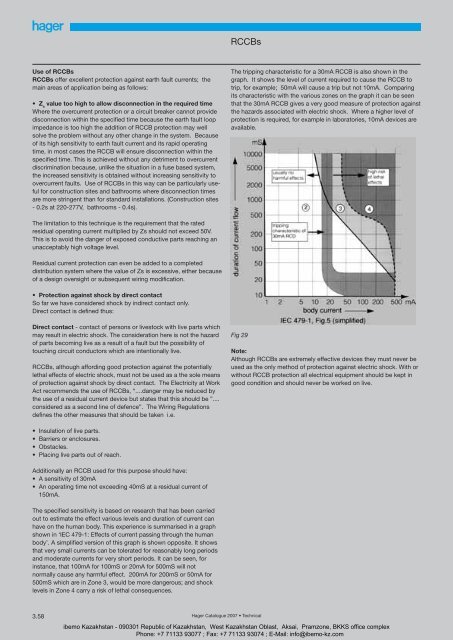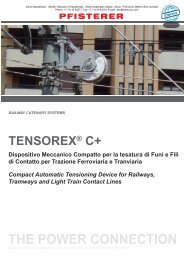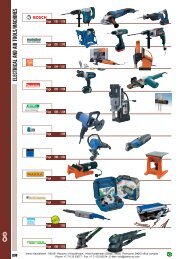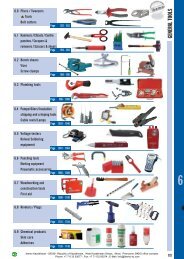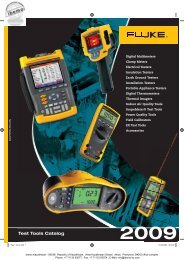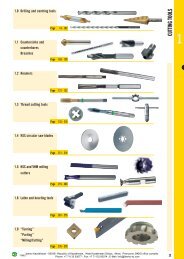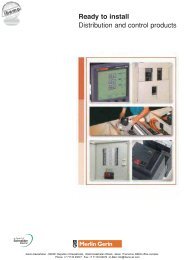General Catalogue 2007 - Ibemo Kazakhstan Ltd
General Catalogue 2007 - Ibemo Kazakhstan Ltd
General Catalogue 2007 - Ibemo Kazakhstan Ltd
Create successful ePaper yourself
Turn your PDF publications into a flip-book with our unique Google optimized e-Paper software.
Use of RCCBs<br />
RCCBs offer excellent protection against earth fault currents; the<br />
main areas of application being as follows:<br />
• Z s value too high to allow disconnection in the required time<br />
Where the overcurrent protection or a circuit breaker cannot provide<br />
disconnection within the specified time because the earth fault loop<br />
impedance is too high the addition of RCCB protection may well<br />
solve the problem without any other change in the system. Because<br />
of its high sensitivity to earth fault current and its rapid operating<br />
time, in most cases the RCCB will ensure disconnection within the<br />
specified time. This is achieved without any detriment to overcurrent<br />
discrimination because, unlike the situation in a fuse based system,<br />
the increased sensitivity is obtained without increasing sensitivity to<br />
overcurrent faults. Use of RCCBs in this way can be particularly useful<br />
for construction sites and bathrooms where disconnection times<br />
are more stringent than for standard installations. (Construction sites<br />
- 0.2s at 220-277V, bathrooms - 0.4s).<br />
The limitation to this technique is the requirement that the rated<br />
residual operating current multiplied by Zs should not exceed 50V.<br />
This is to avoid the danger of exposed conductive parts reaching an<br />
unacceptably high voltage level.<br />
Residual current protection can even be added to a completed<br />
distribution system where the value of Zs is excessive, either because<br />
of a design oversight or subsequent wiring modification.<br />
• Protection against shock by direct contact<br />
So far we have considered shock by indirect contact only.<br />
Direct contact is defined thus:<br />
Direct contact - contact of persons or livestock with live parts which<br />
may result in electric shock. The consideration here is not the hazard<br />
of parts becoming live as a result of a fault but the possibility of<br />
touching circuit conductors which are intentionally live.<br />
RCCBs, although affording good protection against the potentially<br />
lethal effects of electric shock, must not be used as a the sole means<br />
of protection against shock by direct contact. The Electricity at Work<br />
Act recommends the use of RCCBs, “....danger may be reduced by<br />
the use of a residual current device but states that this should be ”....<br />
considered as a second line of defence”. The Wiring Regulations<br />
defines the other measures that should be taken i.e.<br />
• Insulation of live parts.<br />
• Barriers or enclosures.<br />
• Obstacles.<br />
• Placing live parts out of reach.<br />
Additionally an RCCB used for this purpose should have:<br />
• A sensitivity of 30mA<br />
• An operating time not exceeding 40mS at a residual current of<br />
150mA.<br />
The specified sensitivity is based on research that has been carried<br />
out to estimate the effect various levels and duration of current can<br />
have on the human body. This experience is summarised in a graph<br />
shown in ‘IEC 479-1: Effects of current passing through the human<br />
body’. A simplified version of this graph is shown opposite. It shows<br />
that very small currents can be tolerated for reasonably long periods<br />
and moderate currents for very short periods. It can be seen, for<br />
instance, that 100mA for 100mS or 20mA for 500mS will not<br />
normally cause any harmful effect. 200mA for 200mS or 50mA for<br />
500mS which are in Zone 3, would be more dangerous; and shock<br />
levels in Zone 4 carry a risk of lethal consequences.<br />
3.58<br />
RCCBs<br />
Hager <strong>Catalogue</strong> <strong>2007</strong> • Technical<br />
The tripping characteristic for a 30mA RCCB is also shown in the<br />
graph. It shows the level of current required to cause the RCCB to<br />
trip, for example; 50mA will cause a trip but not 10mA. Comparing<br />
its characteristic with the various zones on the graph it can be seen<br />
that the 30mA RCCB gives a very good measure of protection against<br />
the hazards associated with electric shock. Where a higher level of<br />
protection is required, for example in laboratories, 10mA devices are<br />
available.<br />
Fig 29<br />
Note:<br />
Although RCCBs are extremely effective devices they must never be<br />
used as the only method of protection against electric shock. With or<br />
without RCCB protection all electrical equipment should be kept in<br />
good condition and should never be worked on live.<br />
ibemo <strong>Kazakhstan</strong> - 090301 Republic of <strong>Kazakhstan</strong>, West <strong>Kazakhstan</strong> Oblast, Aksai, Pramzone, BKKS office complex<br />
Phone: +7 71133 93077 ; Fax: +7 71133 93074 ; E-Mail: info@ibemo-kz.com


